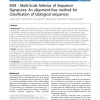Free Online Productivity Tools
i2Speak
i2Symbol
i2OCR
iTex2Img
iWeb2Print
iWeb2Shot
i2Type
iPdf2Split
iPdf2Merge
i2Bopomofo
i2Arabic
i2Style
i2Image
i2PDF
iLatex2Rtf
Sci2ools
BMCBI
2010
2010
MS4 - Multi-Scale Selector of Sequence Signatures: An alignment-free method for classification of biological sequences
Background: While multiple alignment is the first step of usual classification schemes for biological sequences, alignment-free methods are being increasingly used as alternatives when multiple alignments fail. Subword-based combinatorial methods are popular for their low algorithmic complexity (suffix trees ...) or exhaustivity (motif search), in general with fixed length word and/or number of mismatches. We developed previously a method to detect local similarities (the N-local decoding) based on the occurrences of repeated subwords of fixed length, which does not impose a fixed number of mismatches. The resulting similarities are, for some "good" values of N, sufficiently relevant to form the basis of a reliable alignment-free classification. The aim of this paper is to develop a method that uses the similarities detected by N-local decoding while not imposing a fixed value of N. We present a procedure that selects for every position in the sequences an adaptive value of ...
| Added | 08 Dec 2010 |
| Updated | 08 Dec 2010 |
| Type | Journal |
| Year | 2010 |
| Where | BMCBI |
| Authors | Eduardo Corel, Florian Pitschi, Ivan Laprevotte, Gilles Grasseau, Gilles Didier, Claudine Devauchelle |
Comments (0)

